The siciliana or siciliano is a musical style or genre often included as a movement within larger pieces of music starting in the Baroque period. It is in a slow 6
8 or 12
8 time with lilting rhythms, making it somewhat resemble a slow jig or tarantella, and is usually in a minor key. It was used for arias in Baroque operas, and often appears as a movement in instrumental works. Loosely associated with Sicily, the siciliana evokes a pastoral mood, and is often characterized by dotted rhythms that can distinguish it within the broader musical genre of the pastorale.
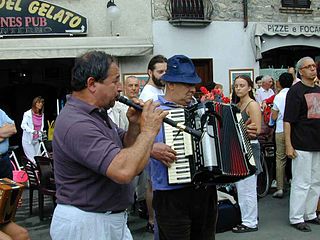
The piffero or piffaro is a double-reed musical instrument of the oboe family with a conical bore . It is used to play music in the tradition of the Quattro Province, an area of mountains and valleys in the north-west Italian Apennines which includes parts of the four provinces of Alessandria, Genoa, Piacenza and Pavia. It is also played throughout Southern Italy with different fingering styles dictated by local tradition.

Ulla Winblad is a semi-fictional character in many of Carl Michael Bellman's musical works. She is at once an idealised rococo goddess and a tavern prostitute, and a key figure in Bellman's songs of Fredman's Epistles. The juxtaposition of elegant and low life is humorous, while allowing Bellman to convey a range of emotions. Ulla Winblad has been called "one of the really great female figures in Swedish literature". The character was partly inspired by Maria Kristina Kiellström (1744–1798).

Fredmans epistlar is a collection of 82 poems set to music by Carl Michael Bellman, a major figure in Swedish 18th century song. Though first published in 1790, it was created over a period of twenty years from 1768 onwards. A companion volume, Fredmans sånger was published the following year.

"Gubben Noak" is a traditional Swedish song, a drinking song and bible travesty written in 1766 or earlier by Carl Michael Bellman. The song is possibly the best known of all Bellman's works. The song was initially published anonymously for fear of the church. In 1768 the Lund chapter attempted to have all copies of the song and other biblical travesties destroyed. It was included in the 1936 Songs for the Philologists by J. R. R. Tolkien and E. V. Gordon. Simplified and more innocent versions of the song are widely sung by children around the world. English versions have been recorded by Adam McNaughtan and the Linköping University Male Voice Choir.

Ulla! min Ulla! säj, får jag dig bjuda, is one of the Swedish poet and performer Carl Michael Bellman's best-known and best-loved songs, from his 1790 collection, Fredman's Epistles, where it is No. 71. A pastorale, it depicts the Rococo muse Ulla Winblad, as the narrator offers her "reddest strawberries in milk and wine" in the Djurgården countryside north of Stockholm.

Hvila vid denna källa is a song by the Swedish poet and performer Carl Michael Bellman from his 1790 collection, Fredman's Epistles, where it is No. 82, the final Epistle. It is subtitled "Eller Oförmodade avsked, förkunnat vid Ulla Winblads frukost en sommarmorgon i det gröna. Pastoral dedicerad till Kgl. Sekreteraren Leopoldt" . It depicts the Rococo muse Ulla Winblad, as the narrator offers a "little breakfast" of "red wine with burnet, and a newly-shot snipe" in a pastoral setting in the Stockholm countryside.
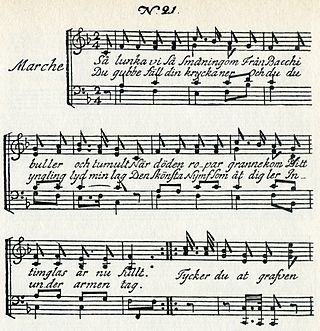
Så lunka vi så småningom is a song from the Swedish poet and performer Carl Michael Bellman's 1791 collection, Fredman's Songs, where it is No. 21. The song, written a few months after the death of his son Eli, is addressed to his hosts at a meal. It makes light of death, while presenting it to each person individually, of high or low rank in society. The refrain sings of a pair of gravediggers discussing whether the grave is too deep, taking repeated swigs from a bottle of brandy.
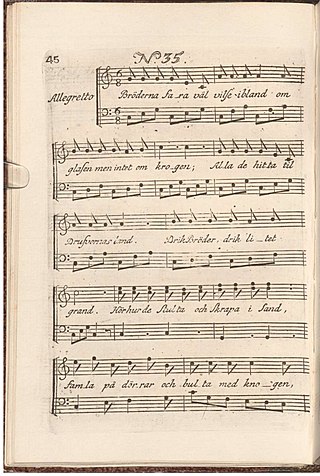
Bröderna fara väl vilse ibland, is a song by the Swedish poet and performer Carl Michael Bellman, from his 1790 collection, Fredman's Epistles, where it is No. 35. The epistle is subtitled "Angående sin Sköna och hännes obeständighet.". The first verse ends "My girl has forgotten me, I'll die faithful. Night and day in drunkenness, shall all my sorrow pass away."

Blåsen nu alla, "All blow now!", is one of the Swedish poet and performer Carl Michael Bellman's best-known and best-loved songs, from his 1790 collection, Fredman's Epistles, where it is No. 25. It is a pastorale, based on François Boucher's rococo 1740 painting Triumph of Venus.

Glimmande nymf, is a song by the Swedish poet and performer Carl Michael Bellman from his 1790 collection, Fredman's Epistles, where it is No. 72. It is subtitled "Lemnad vid Cajsa Lisas Säng, sent om en afton", and set to a melody by Egidio Duni. A night-piece, it depicts a Rococo muse in the Ulla Winblad mould, asleep in her bed in Stockholm, complete with allusions to both classical and Nordic mythology.

Liksom en Herdinna, högtids klädd, is a song by the Swedish poet and performer Carl Michael Bellman from his 1790 collection, Fredman's Epistles, where it is No. 80. The Epistle is subtitled "Angående Ulla Winblads Lustresa til Första Torpet, utom Kattrumps Tullen". It is a pastorale, starting with a near-paraphrase of Nicolas Boileau-Despréaux's French guide to the construction of pastoral verse. That doesn't prevent the supposed shepherd and shepherdess from falling into bed drunk at the end of the song. It has been described as lovelier in Swedish than in Boileau's original French. The epistle's humorous depiction of the human condition has been praised by critics.
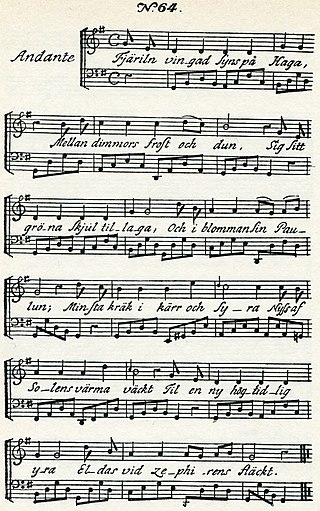
Fjäril'n vingad syns på Haga is one of Carl Michael Bellman's collection of songs called Fredmans sånger, published in 1791, where it is No. 64. The song describes Haga Park, the attractive natural setting of King Gustav III's never-completed Haga Palace just north of Stockholm. An earlier version of the song was a verse petition to obtain a job for Bellman's wife. The composition is one of the most popular of Bellman's songs, being known by many Swedes by heart. It has been recorded many times from 1904 onwards, and translated into English verse at least four times.

Vår Ulla låg i sängen och sov is Epistle No. 36 in the Swedish poet and performer Carl Michael Bellman's 1790 song collection, Fredman's Epistles. The epistle is subtitled "Rörande Ulla Winblad's flykt". It begins with the innkeeper peeping through the keyhole to her bedroom and whispering with his friends as she sleeps, slowly waking up. Then she dresses ornately and enters the tavern, delighting the menfolk until she is suddenly arrested.

I går såg jag ditt barn, min Fröja, is a ballad from the Swedish poet and performer Carl Michael Bellman's 1790 collection, Fredman's Epistles, where it is No. 28. The epistle is subtitled "Om et anstäldt försåt emot Ulla Winblad.". It describes an attempt to arrest the "nymph" Ulla Winblad, based on a real event. The lyrics create a rococo picture of life, blending classical allusion and pastoral description with harsh reality.

Gråt Fader Berg och spela is No. 12 in the Swedish poet and performer Carl Michael Bellman's 1790 song collection, Fredman's Epistles. The epistle is subtitled "Elegi över Slagsmålet på Gröna Lund". It is a lament over a pub brawl, caused by Fredman's drinking a soldier's beer and dancing with someone else's girlfriend. Set to the melody from the aria "The flocks shall leave the mountains" in George Frideric Handel's opera Acis and Galatea, it is the best-known of his poems describing the consequences of brandy-drinking. Bellman used the contrast between the romantic associations of the melody and the brutal reality of heavy drinking to humorous effect.

Movitz blåste en konsert is epistle No. 51 in the Swedish poet and performer Carl Michael Bellman's 1790 song collection, Fredman's Epistles. The epistle is subtitled "Angående konserten på Tre Byttor", naming a restaurant in Stockholm's Djurgården park. It was written after Bellman had become a court musician to the new King Gustav III in 1773. The melody was borrowed from George Frideric Handel's 1718 opera, Acis and Galatea.

Opp Amaryllis! is one of the Swedish poet and performer Carl Michael Bellman's songs from his 1791 collection, Fredman's Songs, where it is No. 31. The song is a graceful pastorale in rococo style, involving a sleeping nymph who is invited to come fishing upon the sea's stormy wave. In reality, the nymph is a Swedish woman, Wilhelmina Norman, the stormy wave is a Swedish waterway, and the progression from shore to fishing-boat can equally well be read as a seduction. It is one of Bellman's best-known and best-loved songs, and has been recorded by musicians including Folke Andersson and Edvard Andreasson.
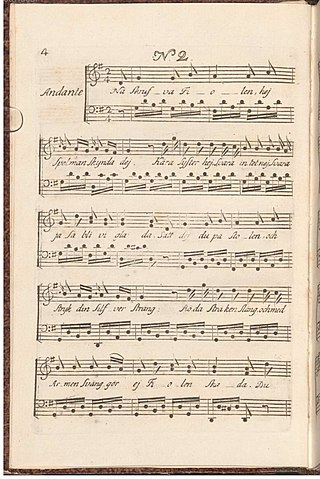
Nå skruva fiolen is Epistle No. 2 in the Swedish poet and performer Carl Michael Bellman's 1790 song collection, Fredman's Epistles. The epistle is subtitled "Till fader Berg, rörande fiolen". It is both about and mimicking the rhythm of playing the violin. The scholar Lars Lönnroth comments that Bellman used the resemblance of a cello to a woman's body, certainly pretending to play it as such for laughs, while the use of words like "screw" in the lyrics was similarly explicitly obscene. The Bellman interpreter Fred Åkerström recorded the song on his 1974 album Glimmande nymf.

Hör klockorna med ängsligt dån or Fredman's Song no. 6 is one of the Swedish 18th century poet and performer Carl Michael Bellman's Fredman's Songs, written in 1769. It is subtitled Över brännvinsbrännaren Lundholm. It was originally one of the texts for Bellman's Order of Bacchus. It was first performed on 15 October 1769, and quickly became popular, spreading as a transcript. It is structured as a funeral oration for a member of Lundholm's Order, parodying the Swedish system of noble Orders.



















